|
|
I
was previously the community director of Whitley
Hall, and tasked with managing the daily operations of the 500-person
residence hall and mentoring 15 student staff members. During my
first year as Whitley's coordinator, residents snacked on delicious
foods, enjoyed positive company, and digested material on stress
relief, sexual and mental health, and drug abuse awareness during
interactive programs. Big changes happened in my second year, including
painting the hallway walls, mounting flat-screen TVs in the lounges,
and installing a new $1 million HVAC system. I thoroughly enjoyed
my 2-year tenure as the 'general manager' of Whitley, bonding with
my staff during office hours and engaging in dynamic discussions
with residents before they went to class. Since Whitley Hall recently
celebrated its 50th anniversary and has had a list of hall directors
and dormitory mothers before me, in this article I offer readers
a brief history of Northeast Texas's tallest building which many
students have called 'home.'
American universities' enrollment numbers exploded following World
War II when young men and women returned from Europe and Asia,
and stepped into the classroom as aspiring undergraduates. The student
body at East Texas State Teachers College in Commerce (ETSTC)
— commonly known as Professor Mayo's college for the poorer
folk in rural Northeast Texas — swelled to over 4,000 students
by the end of the 1940s. This was a 3,000-student increase in just
3 years. James Gilliam Gee, a former staff officer to George S.
Patton, oversaw this period of growth and hungrily predicted a 25,000-30,000-student
increase during the 1950s, 1960s, and 1970s. The anticipation of
more students led to the administration's decision to construct
many academic and athletic facilities in the early years of Gee's
presidency, including the College Farm (1947), Student Union Building
(1948), Field House (1951), and Gee Library (1959). During this
flurry of brick and mortar, President Gee was nicknamed "ET's Great
Builder." It was only a matter of time before the college needed
to build more residence halls (the existing dormitories were filled
to capacity). West Halls apartments for upperclassmen were built
in the early 1960s, but alleviated the campus housing issue temporarily.
Since skyscraper, "cookie-cutter dorms were relatively quick and
inexpensive to build," according to art historian Carla Yanni, Gee
opted to echo the decisions of other university presidents and,
prior to his retirement in 1966, submitted a plan to construct a
high-rise dormitory.
|
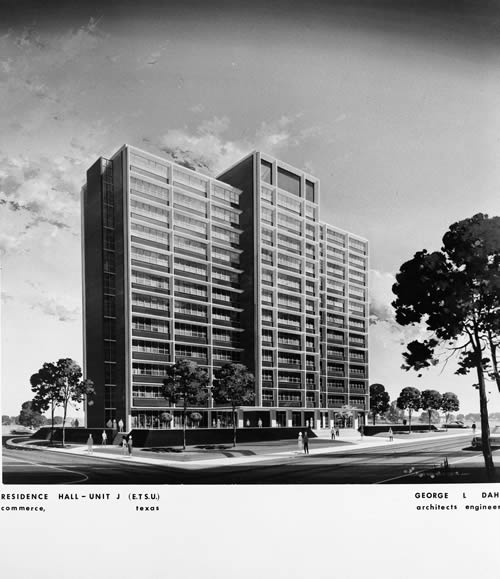 |
| ETSTC's administration
unanimously chose George L. Dahl, a Dallas
architect who had designed 26 art deco-style buildings for the Texas
Centennial Exposition in 1936, to oversee the structural plans
for the new residence hall. The administrators were highly impressed
by Dahl's professional credentials and willingness to listen to his
clients' ideas. Moreover, Dahl already had an established, friendly
relationship with ETSTC since he had designed Binnion Hall (1947)
and Memorial Stadium (1950). Dahl sketched the first blueprint —
titled Residence Hall - Unit J — at the end of 1966. The
drawing depicted a striking structure atop a mound on the south side
of campus, at the intersection of Culver Street and the highway. A
white sidewalk wrapped around the dormitory like a rope and trees
dotted the grassy areas at the front and side of the building. A sizable
white canopy graced the front and rear entrances. The landscaping
was impeccable, but the 12-story brick building was a monstrous, striking
feature. Dahl had envisioned Unit J to have many modernistic touches,
including wide-reaching glass windows and spacious floor plans. Inside,
the central core was planned to house a small basement and 3 high-speed
elevators. Additionally, the high-rise would have three 3 staircases,
2 of which were enclosed by glass panels on the east and west sides
of the structure, and 1 in the center of the building. Gee's successor,
D. Whitney Halladay, praised Dahl's sketch and quickly approved the
plans. |
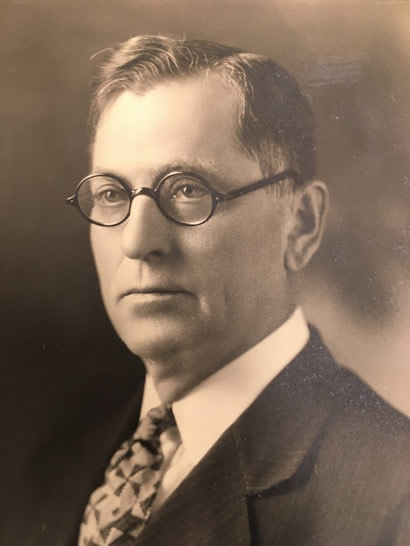 |
| Sam Henry
Whitley, the third president of the college
|
|
The Board of
Regents decided to name the proposed skyscraper dormitory Whitley
Hall in honor of Sam Henry Whitley, the third president of the college.
During his 22 years in the top office (1924-1946), Dr. Whitley enlarged
the student body and physical plant, encouraged the growth of the
athletics program (where the Lions captured many championship titles),
hired the first faculty member with a Ph.D. in 1925, and steered
the institution through the dark days of the Great Depression and
World War II.
Dr. Whitley suddenly died from a heart attack in October 1946, sending
the campus into mourning. Beloved by the faculty and students, Dr.
Whitley left behind a long-lasting legacy — it was no surprise
why the Board chose to commemorate Sam Whitley.
|
|
The
La Roe Construction Company of Dallas arrived on campus and construction
on Whitley Hall began in the spring of 1969. The Farm was razed
to make way for the dormitory. An assortment of trucks, cranes,
and excavators later packed the landscape. Laborers placed the foundation
and the steel pillars that created the building's framework gradually
climbed towards the sky. The floors were stacked like pancakes and
individual windowless units began to materialize. Whitley's bare
skeleton received some substance in the fall when interior walls
were assembled and large window panels were installed in floors
1 to 6. Since construction appeared to be going smoothly, the administration
believed that the high-rise dormitory would be completed on schedule,
prior to January 1, 1970. However, in October, the workers realized
that Whitley Hall was tilting towards campus. After a review, it
was concluded that the structure was being built on a swampy underground
pool. Dahl quickly drew plans for a second building that would connect
to the original and offer support, but these drawings were omitted
due to budget difficulties. Also, the construction workers went
on strike and turned to picketing on campus when La Roe disapproved
their idea of labor unions and higher wages. Construction halted,
agreements were settled, and work resumed in the winter of 1969.
|
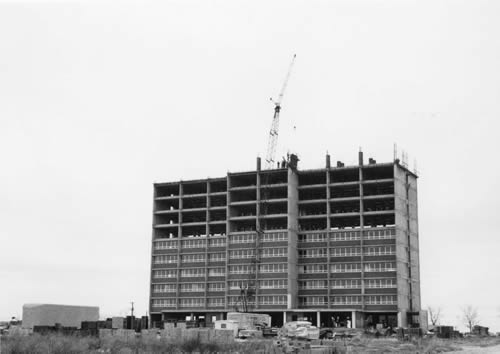 |
| Whitley
Hall Under Construction |
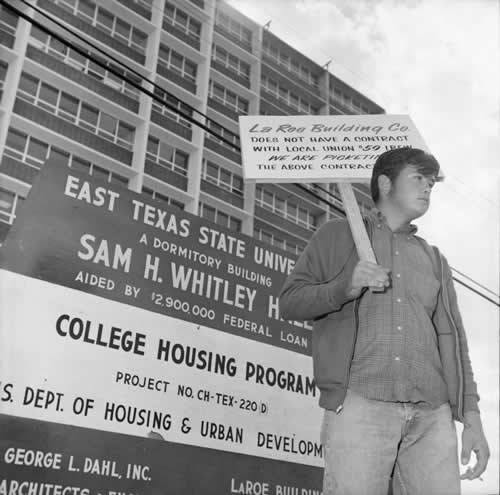 |
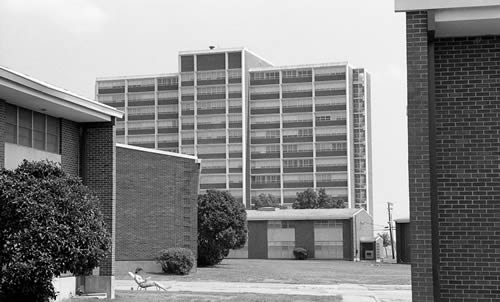 |
| By
the end of January in 1970, exterior work was complete; the dormitory
towered above campus and the City of Commerce, casting a long shadow
over the tiny apartment buildings next door. Whitley Hall was a sight
to behold at sunrise and sunset when the sun glistened from the wide
windows and light flooded the bedrooms inside. The 146-foot residence
hall was magnificent, groundbreaking, breathtaking. Work on the hall's
interior began immediately afterwards. Painters and carpenters replaced
the cranes and trucks, and furniture — which included twin mattresses,
plush couches, nightstands, desks, tilting chairs, dressers, televisions,
and pool tables — was delivered. Once the white and beige paint
had dried, finishing touches were put in before Whitley Hall's grand
opening in March 1970. The building had cost a whopping $2.9 million
to construct (equaling $20.9 million in today's currency). Students
gawked at the large lobby on the first floor, which included comfy
couches and artistic wall decorations. Two furnished 2-bedroom apartments
for the housing staff were also located on the first floor. The students
lived in suite-style rooms on floors 2 through 12 (2 bedrooms shared
a tiled bathroom/shower); Whitley Hall utilized a double-barreled
hallway. Bedrooms had the modern amenities of the decade, which included
electric outlets and hardline telephones. Moreover, each floor had
2 carpeted study rooms and a kitchen. |
| Despite a 616-person
occupancy, Whitley Hall was only 70% occupied when it opened (and
housed male students). The institution's housing department moved
their offices from Henderson Hall to the much-larger first floor quarters
on the west side of Whitley. In a desperate attempt to grow the number
of campus residents, the administration publicized the top floor as
"the hotel," which would accommodate prospective high school students
and their parents. These future Lions must have been thrilled to spend
the night on the twelfth floor of Whitley Hall, observe the night's
stars, and truly experience residential life at the school (for an
inexpensive charge of $5 per room/night). Additionally, guests of
President Halladay were lodged in one of the 28 rooms on the top floor
(prior to the completion of hotels in Hunt
County in the 1990s). |
| Whitley Hall
in the 1980s |
Although Whitley
Hall appeared to be majestic and picturesque, the dormitory was plagued
with facility issues in the first summer. Many residents had originally
complained about not having any water from the tap or showerhead;
the plumbers concluded that the building's valves were not working
properly. The building had also experienced several electrical failures.
Whitley Hall was closed for repairs on July 9, and its summer occupants
were temporarily moved to Sikes Hall (currently the Children's Learning
Center). The dormitory reopened at the start of the 1970 fall semester.
To avoid low occupancy numbers, female students were permitted to
reside in Whitley Hall starting in January 1971. Following Halladay's
sudden resignation in spring 1972, his successor, F.H. "Bub" McDowell
(who was an alumnus), modernized the institution's public image, reconstructed
the curriculum, and provided more assistance to minority students.
Owing to McDowell's strategic plan and inexpensive tuition costs (really
low according to Dr. Bill O'Neal), enrollment peaked in the fall of
1975 at 9,981 students. Whitley Hall (at 85% occupancy) was believed
to have a bright future.
President McDowell firmly believed that enrollment numbers would continue
to soar, and students would populate the many academic and residential
facilities on campus. However, this anticipated growth was a dream,
and enrollment at East Texas State gradually declined in the late
1970s and early 1980s. This was because of decreasing birthrates nationwide
(and an increase in drugstore contraceptives), competition with other
colleges in Texas, and high school students choosing to join the workforce
instead of attending college. When McDowell retired in 1982, it was
not unusual to see bleak hallways, half-empty classrooms, and desolate
sidewalks on campus. Enrollment numbers became dangerously low by
the mid-1980s-6,342 students. Since a majority of students lived in
Hunt County, there
was less of a demand for dormitory rooms. Whitley Hall was nothing
more than a meatless shell as it struggled to lodge more than 50%
occupancy in 1985. Some began to question the wisdom behind the administration's
decision to build a mostly-empty, expensive dorm. Students jokingly
labeled Whitley as a "12-story filing cabinet" and "Halladay's Motel."
|
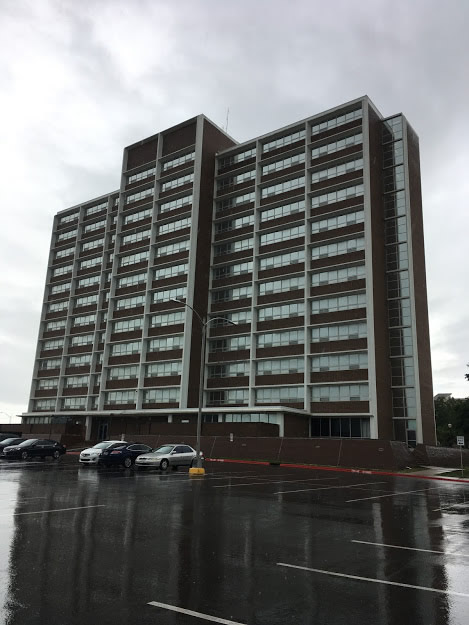 |
| Texas A&M Commerce
Whitley Hall, 2020 |
| Charles
J. Austin, McDowell's successor, saved the institution from the chopping
block in 1985 when the Legislature considered closing the school's
doors. The student body swelled in the late 1980s and 1990s when the
next president, Jerry D. Morris, encouraged international students
to study in Commerce.
Students from England, Italy, India, Brazil, China, France, South
Africa, and Germany lived in the dorms. Whitley Hall dusted its cobwebs
and maintained a healthy occupancy of 550 male and female students
per year. President Morris also approved a major renovation project
at Whitley, which included replacing the kitchens with laundry facilities
and installing fire sprinklers in the bedrooms. Since the World Wide
Web took the world by storm in the 1990s, the Whitley study rooms
were equipped with computers and printers to better serve the technological
needs of the students. |
|
At the turn
of the 21st century, Keith McFarland, Morris's successor, introduced
"Meet & Greet the President," which allowed incoming students moving
in to Whitley Hall to meet the president and faculty. Today, President
Mark Rudin dons Lion gear and greets students and parents at the
residence halls on move-in day. Following the September 11, 2001
attacks, Whitley's residents mourned by either lighting or darking
the bedrooms to spell USA on the north and south sides of the dormitory.
The residents continue to light the sky-rise dormitory every year
to commemorate our selfless veterans and brave soldiers overseas.
Since it is the only skyscraper in the area, county citizens are
able to see the illuminated marvel. I proudly helped to coordinate
"Light-Up Whitley" when I was the community director (and it was
the most heartwarming and rewarding project I undertook during my
tenure). In sum, the physical plant has significantly changed since
Gee's and Halladay's early administrations (and the campus has had
a name change-to Texas A&M University-Commerce). Many of the older
dormitories have closed their doors since the start of the Covid-19
Pandemic, but Whitley Hall has remained standing as a proud testament
to the university's strength and pride. May Whitley Hall stand for
another 50 years…
|
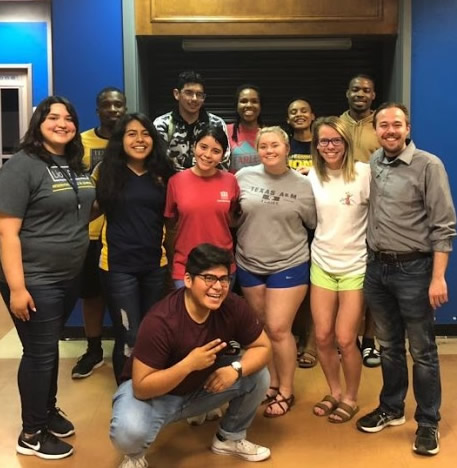 |
Bibliography
Chanin, Joshua. A Photographic History of Texas A&M University-Commerce
(forthcoming).
Reynolds, Donald E. Professor Mayo's College: A History of East
Texas State University (Commerce, Texas: East Texas State University
Press, 1993).
Various Locust yearbooks, student scrapbooks, East Texan articles,
photographs, and documents from the Samuel H. Whitley Papers, Velma
K. Waters Library, Texas A&M University-Commerce |
Author Biography:
Joshua V. Chanin is adjunct instructor of history and community director
of Whitley Hall at Texas A&M University-Commerce. He received his
M.A. in history from the University of Texas at Arlington, and specializes
in the history of women and education in Texas. |
|
|
